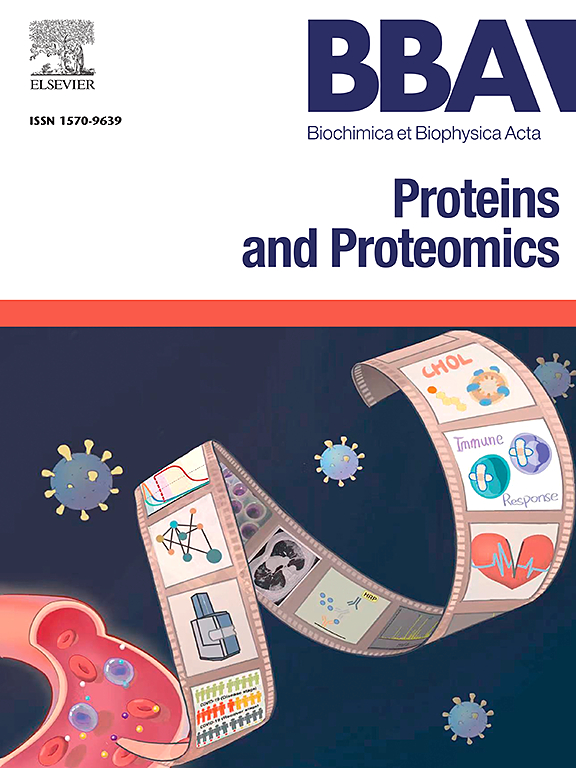Ndufs4 基因敲除小鼠患有孤立的复合体 I 缺乏症,其大脑的适应性反应是徒劳的。
IF 2.3
4区 生物学
Q3 BIOCHEMISTRY & MOLECULAR BIOLOGY
Biochimica et biophysica acta. Proteins and proteomics
Pub Date : 2024-10-11
DOI:10.1016/j.bbapap.2024.141055
引用次数: 0
摘要
小儿利氏综合征(LS)是一种发病较早且致命的神经退行性疾病,目前尚无治疗方法。LS常由NDUFS4基因突变引起,该基因编码线粒体复合体I(CI)的一个附属亚基,而线粒体复合体I是氧化磷酸化(OXPHOS)系统的第一个复合体。全身 Ndufs4 基因敲除(KO)小鼠(WB-KO 小鼠)被广泛用于研究孤立的 CI 缺乏、LS 病理和干预措施。这些动物通过不完全清楚的病理机制形成了大脑特异性表型。在这里,我们对六周大的 WB-KO 小鼠与野生型小鼠的脑下蛋白质组进行了定量分析。脑区包括大脑切片(BrSl)、小脑(CB)、大脑皮层(CC)、海马(HC)、下丘(IC)和上丘(SC)。蛋白质组分析表明,CC/HC 之间以及 IC/SC 之间存在相似性,而 BrSl 和 CB 则与这两组和其他组不同。所有脑区的两个 CI 结构亚基(NDUFS4 和 NDUFA12)的水平都大大降低,而 CI 组装因子 NDUFAF2 的水平则有所提高。与 BrSl/CB/CC/HC 相比,IC/SC 中 CI-Q 模块亚基的水平明显降低,而其他 OXPHOS 复合物的水平并未降低。基因本体和通路分析表明了不同脑区之间蛋白质组的特殊和共同变化。在各个脑区,冷休克相关蛋白、线粒体脂肪酸氧化和合成(mtFAS)的上调最为显著。与脂肪酸相关的通路主要在 CB 和 HC 中上调。基于这些结果,我们认为刺激这些通路是徒劳的,而且会导致病理变化,并讨论了 LS 治疗干预的替代策略。意义:Ndufs4基因敲除小鼠模型是目前研究人类利氏综合征(LS)脑相关病理生理学和干预策略最相关、应用最广泛的动物模型。我们证明,Ndufs4基因敲除的大脑会产生徒劳的和有利于病理的反应。这些反应解释了在莱氏综合征小鼠和患者中进行的干预研究的消极和积极结果,从而为新的干预机会提供了指导。本文章由计算机程序翻译,如有差异,请以英文原文为准。
Ndufs4 knockout mice with isolated complex I deficiency engage a futile adaptive brain response
Paediatric Leigh syndrome (LS) is an early-onset and fatal neurodegenerative disorder lacking treatment options. LS is frequently caused by mutations in the NDUFS4 gene, encoding an accessory subunit of mitochondrial complex I (CI), the first complex of the oxidative phosphorylation (OXPHOS) system. Whole-body Ndufs4 knockout (KO) mice (WB-KO mice) are widely used to study isolated CI deficiency, LS pathology and interventions. These animals develop a brain-specific phenotype via an incompletely understood pathomechanism. Here we performed a quantitative analysis of the sub-brain proteome in six-weeks old WB-KO mice vs. wildtype (WT) mice. Brain regions comprised of a brain slice (BrSl), cerebellum (CB), cerebral cortex (CC), hippocampus (HC), inferior colliculus (IC), and superior colliculus (SC). Proteome analysis demonstrated similarities between CC/HC, and between IC/SC, whereas BrSl and CB differed from these two groups and each other. All brain regions displayed greatly reduced levels of two CI structural subunits (NDUFS4, NDUFA12) and an increased level of the CI assembly factor NDUFAF2. The level of CI-Q module subunits was significantly more reduced in IC/SC than in BrSl/CB/CC/HC, whereas other OXPHOS complex levels were not reduced. Gene ontology and pathway analysis demonstrated specific and common proteome changes between brain regions.
Across brain regions, upregulation of cold-shock-associated proteins, mitochondrial fatty acid (FA) oxidation and synthesis (mtFAS) were the most prominent. FA-related pathways were predominantly upregulated in CB and HC. Based upon these results, we argue that stimulation of these pathways is futile and pro-pathological and discuss alternative strategies for therapeutic intervention in LS.
Significance
The Ndufs4 knockout mouse model is currently the most relevant and most widely used animal model to study the brain-linked pathophysiology of human Leigh Syndrome (LS) and intervention strategies. We demonstrate that the Ndufs4 knockout brain engages futile and pro-pathological responses. These responses explain both negative and positive outcomes of intervention studies in Leigh Syndrome mice and patients, thereby guiding novel intervention opportunities.
求助全文
通过发布文献求助,成功后即可免费获取论文全文。
去求助
来源期刊
CiteScore
8.00
自引率
0.00%
发文量
55
审稿时长
33 days
期刊介绍:
BBA Proteins and Proteomics covers protein structure conformation and dynamics; protein folding; protein-ligand interactions; enzyme mechanisms, models and kinetics; protein physical properties and spectroscopy; and proteomics and bioinformatics analyses of protein structure, protein function, or protein regulation.

 求助内容:
求助内容: 应助结果提醒方式:
应助结果提醒方式:


